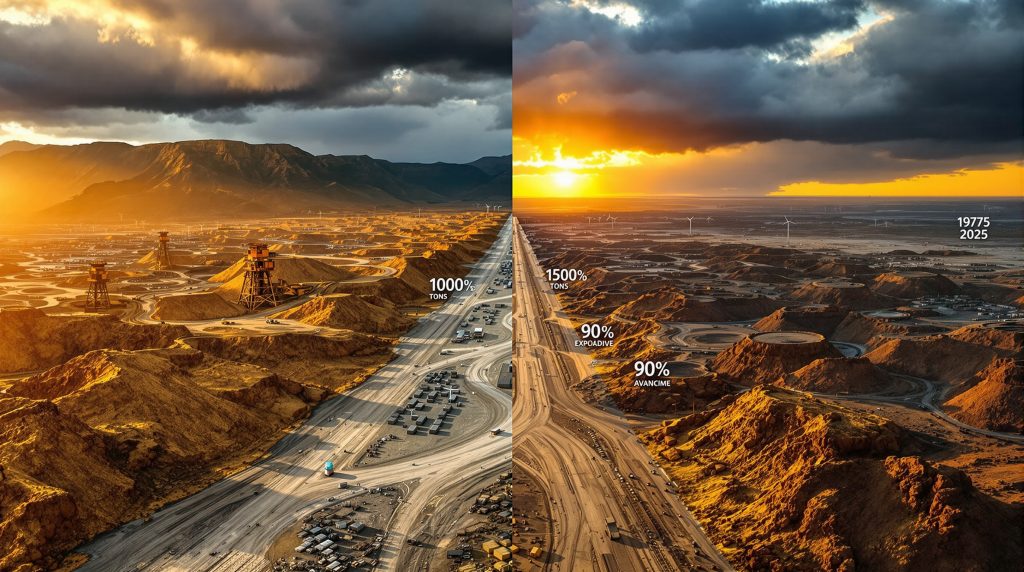South Africa's Lost Exploration Era: Understanding the Mining Decline
South Africa's mining sector, once a global powerhouse, has experienced a significant decline in exploration activities over the past two decades. This exploration deficit has created a critical gap in the country's mining development pipeline, threatening its long-term position in the global minerals market. The consequences of this "lost generation" of exploration in South Africa are now becoming increasingly apparent as existing mines age without adequate replacements in the pipeline.
The 17-Year Development Timeline
Mining projects typically require approximately 17 years from initial discovery to full production. This lengthy timeline encompasses exploration, feasibility studies, mining permitting challenges, construction, and ramp-up phases. With exploration activities severely limited since the early 2000s, South Africa now faces the consequences of this extended development gap.
The mining project lifecycle follows a predictable pattern that requires sustained investment:
- Exploration phase: 3-5 years
- Feasibility studies: 2-4 years
- Permitting and approvals: 2-5 years (often longer in South Africa)
- Construction and commissioning: 3-5 years
- Ramp-up to full production: 1-3 years
Without adequate exploration importance, the pipeline for future mines remains empty, creating long-term production challenges that can't be quickly resolved.
Key Statistics on Exploration Decline
The decline in South Africa's mining sector is reflected in several key metrics:
| Indicator | Historic Performance | Current Status |
|---|---|---|
| Gold Production | ~1,000 metric tons (1970) | ~90 metric tons (2024) |
| Global Gold Share | 50% of world output (1970s) | 4.2% of world output (2024) |
| Mining Contribution to GDP | 21% (1980) | 8.2% (2024) |
| Exploration Investment | Leading destination (pre-2000) | Minimal new project development |
These statistics reveal a sector that has experienced dramatic contraction over decades. The gold sector, once the backbone of South Africa's mining industry, has suffered the most visible decline, with production falling by over 90% from its peak. According to recent analysis, this decline has continued even as global gold prices have reached record levels.
What Policy Factors Have Contributed to the Exploration Crisis?
The dramatic decline in South Africa's mining exploration didn't happen by accident. A combination of policy decisions, regulatory complexity, and governance issues has created an environment where exploration investment has been severely constrained.
Regulatory Uncertainty and Delays
The mining sector has struggled with inconsistent policy implementation and prolonged delays in processing mining rights applications. This uncertainty has created an environment where exploration companies cannot confidently invest in long-term projects.
According to industry participants, permit applications that should take months often extend to years, with some companies reporting waiting periods of 3-5 years for exploration permits. This uncertainty drives capital toward jurisdictions where regulatory timelines are more predictable and transparent.
The administrative bottlenecks include:
- Backlogs in application processing at Department of Mineral Resources offices
- Frequent changes in interpretation of regulations
- Multiple layers of approval required across different government departments
- Lack of coordination between national, provincial, and local authorities
Mining Charter Challenges
Multiple iterations of the Mining Charter have created a shifting regulatory landscape. Investors cite concerns about:
- Changing ownership requirements across different versions (2004, 2010, 2018)
- Inconsistent application of regulations between regions and officials
- Unpredictable compliance costs that impact financial modeling
- Lengthy administrative processes that delay project timelines
- Retroactive application of new requirements to existing operations
The uncertainty surrounding ownership requirements has been particularly damaging for exploration, as junior companies struggle to attract investment when the ultimate ownership structure remains unclear. International investors consistently cite these regulatory uncertainties as major deterrents to committing exploration capital in South Africa.
Land Access and Rights Issues
Exploration companies face significant challenges in:
- Securing clear title to exploration areas
- Navigating complex community consultation requirements
- Resolving overlapping land claims that create legal uncertainty
- Managing environmental permitting processes that lack clear timelines
- Addressing historical land rights disputes that complicate new developments
Land access issues are particularly problematic for exploration, as companies need to evaluate multiple potential sites before identifying viable mineral deposits. When each land access negotiation becomes a complex legal and community engagement challenge, the economics of exploration deteriorate rapidly.
How Has Infrastructure Deterioration Affected Exploration?
Beyond regulatory challenges, South Africa's deteriorating infrastructure has created additional obstacles for mining exploration and development.
Energy Supply Challenges
Persistent power shortages have severely impacted the mining sector's ability to operate efficiently:
- Unreliable electricity supply increases operational risks and exploration costs
- Higher energy costs reduce project viability, particularly for marginal deposits
- Power rationing disrupts exploration activities, extending timelines
- Backup power requirements increase capital expenditure for projects
- Energy uncertainty complicates long-term planning and investment decisions
The energy crisis has been particularly detrimental to exploration companies with limited financial resources. Unlike major mining companies, junior explorers typically lack the capital to invest in alternative energy solutions, making them especially vulnerable to grid instability.
Transportation and Logistics Barriers
The deterioration of South Africa's rail, port, and road infrastructure has created additional obstacles:
- Limited rail capacity for mineral exports constrains growth potential
- Port congestion and inefficiencies increase costs and delay shipments
- Deteriorating road networks in mining regions increase transportation costs
- Increasing security concerns for transported goods add security premiums
- Reduced maintenance of secondary roads hampers access to exploration sites
For exploration companies evaluating potential projects, these logistical challenges factor into feasibility calculations. When infrastructure constraints threaten future profitability, marginal projects that might be viable in regions with better infrastructure are abandoned.
What Has Been the Economic Impact of Reduced Exploration?
The exploration deficit has created far-reaching economic consequences beyond the mining sector itself.
Lost Job Creation Opportunities
The exploration gap has significant employment implications:
- Major mining projects typically create thousands of direct jobs during construction and operation
- Indirect employment multiplier effects extend job creation throughout local economies
- Specialized mining skills development opportunities have been missed
- Regional economic development potential remains unrealized in mining-dependent areas
- Youth unemployment in traditional mining regions has worsened with fewer new projects
The loss of potential employment is particularly significant in rural areas where mining often represents the primary source of formal employment opportunities. As older mines close without new developments to replace them, entire communities face economic dislocation.
Investment Capital Redirection
Major mining companies have redirected capital that might have been invested in South Africa:
- AngloGold Ashanti has prioritized operations in Australia, Ghana, and the Americas
- Gold Fields has expanded significantly in Australia and the Americas
- Anglo American has reduced its South African footprint, divesting assets including its 19.1% stake in Valterra Platinum in 2025
- Junior miners have shifted focus to more exploration-friendly jurisdictions like West Africa and Latin America
- Venture capital for mining startups has largely bypassed South Africa
These investment redirections represent billions of dollars in capital that could have developed new mines, created jobs, and generated tax revenue for South Africa. The cumulative effect of these decisions has been a significant reduction in the mining sector's contribution to the national economy.
Downstream Industry Effects
The exploration gap impacts numerous related sectors:
- Mining equipment manufacturers have lost potential domestic customers
- Engineering and consulting services have experienced reduced demand
- Logistics and transportation providers have missed growth opportunities
- Financial and legal services specialized in mining have seen market contraction
- Educational institutions have reduced mining-related programs due to declining demand
These downstream effects multiply the economic impact of reduced exploration activity. Each mining project supports an ecosystem of suppliers, service providers, and specialized professionals. When new projects don't materialize, this entire economic ecosystem suffers.
How Does South Africa Compare to Other Mining Jurisdictions?
The decline in South African exploration becomes even more apparent when comparing the country's performance to other major mining jurisdictions.
Global Exploration Investment Trends
While South Africa's exploration activity has declined, other regions have seen significant growth:
- Australia attracts approximately 12-15% of global exploration spending through supportive policies and geological data access
- Canada captures around 15-18% of worldwide exploration investment with tax incentives and provincial support programs
- Latin American countries collectively receive about 25% of global exploration capital, with Chile and Peru leading
- West African nations have emerged as exploration hotspots with improving governance and favorable geology
- South Africa now attracts less than 1% of global exploration investment despite its mineral wealth
This redistribution of exploration capital reflects both push factors (challenges in South Africa) and pull factors (improvements in competing jurisdictions). The competition for exploration investment has intensified globally, with countries actively implementing policies to attract capital.
Policy Environment Comparison
Countries successfully attracting exploration investment typically offer:
- Clear, stable regulatory frameworks with predictable timelines
- Efficient permitting processes with defined decision points
- Competitive fiscal regimes with exploration incentives
- Strong infrastructure support including energy and transportation
- Accessible geological data through modernized geological surveys
- Supportive services for junior miners and exploration companies
Australia and Canada, in particular, have implemented specific programs to encourage mineral exploration. These include flow-through share mechanisms that allow exploration companies to pass tax deductions to investors, as well as co-funding programs for early-stage exploration drilling.
What Solutions Could Revitalize South African Exploration?
Despite the significant challenges, pathways exist to revitalize South Africa's exploration sector.
Policy Reform Priorities
Industry experts suggest several key policy improvements:
- Streamlining the mining rights application process with clear timelines and accountability
- Creating tax incentives specifically for exploration activities, similar to successful models in Canada and Australia
- Establishing regulatory certainty with fixed-term policy commitments that allow long-term planning
- Developing transparent community engagement frameworks that balance local interests with development needs
- Reforming the cadastral system to provide clear property rights and reduce overlapping claims
These reforms would address the primary concerns that have deterred exploration investment. By creating a more predictable environment, South Africa could begin to rebuild investor confidence and attract capital back to the sector.
Public-Private Partnership Opportunities
Collaborative approaches could help address infrastructure challenges:
- Joint development of power generation solutions, including renewable energy for mining regions
- Shared investment in rail and port infrastructure to ensure export capacity
- Cooperative security arrangements for mining regions to protect assets and personnel
- Combined skills development initiatives to build local technical capacity
- Public-private geological mapping initiatives to identify prospective areas
These partnerships acknowledge that neither government nor industry can solve the challenges alone. By sharing costs, risks, and responsibilities, public-private initiatives could overcome barriers that have stalled exploration investment.
Geological Survey Modernization
Updating and expanding geological data accessibility would reduce exploration risk:
- Digitizing historical exploration records to preserve valuable data
- Conducting new regional geophysical surveys using modern technologies
- Creating open-access data platforms for explorers to encourage new entrants
- Developing 3D geological modelling of key mineral provinces
- Implementing machine learning to identify exploration targets from existing data
Modern geological surveys in successful mining jurisdictions have transformed from traditional mapping organizations to digital data providers. By following similar models, South Africa could significantly reduce the initial risk for exploration companies, making the country more attractive for investment.
What Are the Critical Minerals Opportunities Being Missed?
The exploration gap is particularly concerning given South Africa's potential in minerals critical for the global energy transition.
Battery Metals Potential
South Africa has significant untapped potential in minerals critical for the energy transition:
- Manganese reserves (largest globally at approximately 70-75% of known resources)
- Vanadium deposits (significant for grid-scale batteries and energy storage)
- Nickel and cobalt occurrences that remain underexplored
- Rare earth element potential in various geological settings
- Lithium prospects that have received minimal modern exploration
As global demand for these minerals increases with the expansion of electric vehicles and renewable energy, South Africa risks missing a generational opportunity. Without exploration investment today, the country will be unable to participate fully in these growth markets over the coming decades.
Platinum Group Metals Expansion
Despite being a leading producer, South Africa's PGM sector faces exploration limitations:
- Deeper ore bodies requiring advanced exploration techniques
- Potential for new reef discoveries with modern technology
- Opportunities for more efficient extraction methods
- Growing demand for PGMs in hydrogen technologies and emission control
- Expansion potential in the eastern limb of the Bushveld Complex
The PGM sector represents one of South Africa's remaining mining strengths, but continued leadership requires ongoing exploration to replace depleting reserves and identify new opportunities. The transition to hydrogen technologies could create significant new demand for platinum, but only if supply can be secured.
What Would a Revitalized Exploration Sector Look Like?
A renewed focus on exploration would transform South Africa's mining sector and create new opportunities for economic development.
New Generation Mining Projects
A renewed exploration focus could deliver:
- Modern, technologically advanced mining operations with reduced environmental impacts
- Lower environmental footprints through innovative design and operational practices
- Community-integrated development models with shared benefits
- Digitally optimized production systems using artificial intelligence and automation
- Smaller, more focused operations targeting high-value deposits
These next-generation mines would differ significantly from the legacy operations that have dominated South Africa's mining landscape. Rather than massive, labor-intensive operations, new mines would likely be more technically sophisticated, environmentally conscious, and integrated with local communities.
Skills Development Renaissance
Revitalized exploration would create opportunities for:
- Training a new generation of South African geologists with advanced technical skills
- Developing specialized technical capabilities in geophysics, geochemistry, and data science
- Building local exploration service companies to support field activities
- Establishing centers of excellence in mining innovation and sustainability
- Creating knowledge transfer programs between international and local experts
This skills development would have benefits far beyond the mining sector itself. The technical capabilities developed through exploration activities are transferable to other industries, creating a broader base of technical expertise within the South African economy.
FAQ: South Africa's Mining Exploration Crisis
Why does exploration matter if South Africa already has established mines?
Exploration is the lifeblood of the mining industry. Without ongoing exploration, existing mines eventually deplete their reserves, leading to declining production, job losses, and reduced economic contribution. New discoveries are essential for sustaining the industry over the long term.
The typical life cycle of a mine runs from 15-30 years, depending on the size of the deposit and extraction rates. South Africa's existing operations are largely mature mines approaching the end of their productive lives. Without new discoveries, the sector faces inevitable contraction.
How long would it take to reverse the exploration deficit?
Even with immediate policy reforms, the effects of the "lost generation" of exploration will continue to impact South Africa's mining sector for years. Given the typical 17-year development timeline, policy changes implemented today might only show significant results in the 2030s and beyond.
This lengthy timeline emphasizes the urgency of addressing the exploration crisis. The longer reforms are delayed, the more extended the period of reduced mining activity will be. This creates a compelling case for immediate action rather than incremental change.
What role can technology play in addressing the exploration gap?
Advanced technologies like artificial intelligence, machine learning, drone surveys, and improved geophysical techniques can help accelerate the exploration process and identify targets that might have been missed with older methods. However, these technologies require investment and supportive regulatory frameworks.
South Africa has an opportunity to leapfrog older exploration methodologies by adopting these technologies. By creating a regulatory environment that embraces industry evolution trends, the country could potentially compress traditional exploration timelines and reduce costs.
How does the exploration crisis affect South Africa's energy transition plans?
Many minerals essential for renewable energy technologies and battery storage systems require new exploration to expand production. Without addressing the exploration deficit, South Africa may miss opportunities to participate fully in the global energy transition supply chain.
The country has significant potential in several critical minerals needed for clean energy technologies, including manganese, vanadium, and platinum group metals. However, realizing this potential requires a fundamental shift in approach to mineral exploration and development.
The Path Forward
Reversing South Africa's exploration decline requires a coordinated effort from government, industry, and communities. The 17-year development timeline means that actions taken today will only bear fruit in the 2030s and beyond, emphasizing the urgency of addressing the exploration crisis immediately rather than incrementally.
While the challenges are significant, South Africa retains fundamental advantages including exceptional mineral endowment, established mining expertise, and developed financial markets. By addressing the policy, infrastructure, and data barriers that have hindered exploration, the country has the potential to rebuild its position as a global mining leader and capture opportunities in the emerging critical minerals economy.
The lost generation of exploration cannot be recovered, but with decisive action, South Africa can prevent the loss of another generation and begin rebuilding its mining future. As highlighted by top mining CEOs, the country is missing significant opportunities while failing to implement South Africa beneficiation strategies that could add substantial economic value.
Ready to Discover the Next Big Resource Play?
Stay ahead of the market with Discovery Alert's proprietary Discovery IQ model, which instantly identifies significant ASX mineral discoveries and translates complex data into actionable investment insights. Explore how historic discoveries have generated substantial returns by visiting the Discovery Alert discoveries page and position yourself for the next major opportunity.




